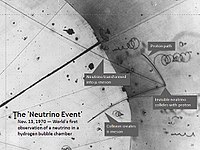
Photo from wikipedia
A number of derivations of the standard neutrino oscillation formula are known, each one providing its own unique insights. Common to all treatments is the assumption that neutrinos propagate freely… Click to show full abstract
A number of derivations of the standard neutrino oscillation formula are known, each one providing its own unique insights. Common to all treatments is the assumption that neutrinos propagate freely between source and detector, as indeed they do in all experiments thus far conducted. Here, we consider how neutrinos oscillate when contrary to the usual setup, they are bound in a potential well. The focus in particular is on nonrelativistic neutrinos with quasi-degenerate masses, for which oscillations in free space are described by the same formula, to lowest order, as relativistic neutrinos. Trapping these particles engenders corrections to their oscillation frequencies because the interference terms are between discrete energy levels rather than continuous spectra. Especially novel is the frequency shift that occurs due to the dependence of the energy levels on the mass of the neutrino: this part of the correction is nonvanishing even in the extremely nonrelativistic limit, reflecting the fact that the neutrino mass states have different zero-point energies in the well. Building an apparatus that can trap neutrinos is a futuristic prospect to say the least, but these calculations nonetheless shine a light on certain basic aspects of the flavor-oscillation phenomenon.
Journal Title: International Journal of Modern Physics A
Year Published: 2019
Link to full text (if available)
Share on Social Media: Sign Up to like & get
recommendations!